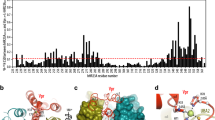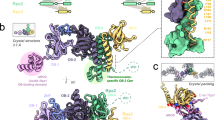Abstract
The oncoprotein large tumour antigen (LTag) is encoded by the DNA tumour virus simian virus 40. LTag transforms cells and induces tumours in animals by altering the functions of tumour suppressors (including pRB and p53) and other key cellular proteins. LTag is also a molecular machine that distorts/melts the replication origin of the viral genome and unwinds duplex DNA. LTag therefore seems to be a functional homologue of the eukaryotic minichromosome maintenance (MCM) complex. Here we present the X-ray structure of a hexameric LTag with DNA helicase activity. The structure identifies the p53-binding surface and reveals the structural basis of hexamerization. The hexamer contains a long, positively charged channel with an unusually large central chamber that binds both single-stranded and double-stranded DNA. The hexamer organizes into two tiers that can potentially rotate relative to each other through connecting α-helices to expand/constrict the channel, producing an ‘iris’ effect that could be used for distorting or melting the origin and unwinding DNA at the replication fork.
This is a preview of subscription content, access via your institution
Access options
Subscribe to this journal
Receive 51 print issues and online access
$199.00 per year
only $3.90 per issue
Buy this article
- Purchase on Springer Link
- Instant access to full article PDF
Prices may be subject to local taxes which are calculated during checkout






Similar content being viewed by others
References
Pipas, J. M. Common and unique features of T antigens encoded by the polyomavirus group. J. Virol. 66, 3979–3985 (1992)
Simmons, D. T. SV40 large T antigen functions in DNA replication and transformation. Adv. Virus Res. 55, 75–134 (2000)
Stillman, B. Smart machines at the DNA replication fork. Cell 78, 725–728 (1994)
Bullock, P. A. The initiation of simian virus 40 DNA replication in vitro. Crit. Rev. Biochem. Mol. Biol. 32, 503–568 (1997)
Mastrangelo, I. A. et al. ATP-dependent assembly of double hexamers of SV40 T antigen at the viral origin of DNA replication. Nature 338, 658–662 (1989)
Borowiec, J. A. & Hurwitz, J. Localized melting and structural changes in the SV40 origin of replication induced by T-antigen. EMBO J. 7, 3149–3158 (1988)
Joo, W. S., Kim, H. Y., Purviance, J. D., Sreekumar, K. R. & Bullock, P. A. Assembly of T-antigen double hexamers on the simian virus 40 core origin requires only a subset of the available binding sites. Mol. Cell. Biol. 18, 2677–2687 (1998)
Dean, F. B. et al. Simian virus 40 (SV40) DNA replication: SV40 large T antigen unwinds DNA containing the SV40 origin of replication. Proc. Natl Acad. Sci. USA 84, 16–20 (1987)
Wold, M. S., Li, J. J. & Kelly, T. J. Initiation of simian virus 40 DNA replication in vitro: Large-tumor-antigen- and origin-dependent unwinding of the template. Proc. Natl Acad. Sci. USA 84, 3643–3647 (1987)
Smelkova, N. V. & Borowiec, J. A. Synthetic DNA replication bubbles bound and unwound with twofold symmetry by a simian virus 40 T-antigen double hexamer. J. Virol. 72, 8676–8681 (1998)
Tsurimoto, T., Melendy, T. & Stillman, B. Sequential initiation of lagging and leading strand synthesis by two different polymerase complexes at the SV40 DNA replication origin. Nature 346, 534–539 (1990)
Tsurimoto, T. & Stillman, B. Replication factors required for SV40 DNA replication in vitro. II. Switching of DNA polymerase α and δ during initiation of leading and lagging strand synthesis. J. Biol. Chem. 266, 1961–1968 (1991)
Wun-Kim, K. & Simmons, D. T. Mapping of helicase and helicase substrate-binding domains on simian virus 40 large T antigen. J. Virol. 64, 2014–2020 (1990)
Wu, C., Roy, R. & Simmons, D. T. Role of single-stranded DNA binding activity of T antigen in simian virus 40 DNA replication. J. Virol. 75, 2839–2847 (2001)
Borowiec, J. A., Dean, F. B., Bullock, P. A. & Hurwitz, J. Binding and unwinding—how T antigen engages the SV40 origin of DNA replication. Cell 60, 181–184 (1990)
Fanning, E. & Knippers, R. Structure and function of simian virus 40 large tumor antigen. Annu. Rev. Biochem. 61, 55–85 (1992)
Koonin, E. V. A common set of conserved motifs in a vast variety of putative nucleic acid-dependent ATPases including MCM proteins involved in the initiation of eukaryotic DNA replication. Nucleic Acids Res. 21, 2541–2547 (1993)
Neuwald, A. F., Aravind, L., Spouge, J. L. & Koonin, E. V. AAA + : A class of chaperone-like ATPases associated with the assembly, operation, and disassembly of protein complexes. Genome Res. 9, 27–43 (1999)
Beachy, T. M., Cole, S. L., Cavender, J. F. & Tevethia, M. J. Regions and activities of simian virus 40 T antigen that cooperate with an activated ras oncogene in transforming primary rat embryo fibroblasts. J. Virol. 76, 3145–3157 (2002)
Cavender, J. F., Conn, A., Epler, M., Lacko, H. & Tevethia, M. J. Simian virus 40 large T antigen contains two independent activities that cooperate with a ras oncogene to transform rat embryo fibroblasts. J. Virol. 69, 923–934 (1995)
Valle, M., Gruss, C., Halmer, L., Carazo, J. M. & Donate, L. E. Large T-antigen double hexamers imaged at the simian virus 40 origin of replication. Mol. Cell. Biol. 20, 34–41 (2000)
Luo, X., Sanford, D. G., Bullock, P. A. & Bachovchin, W. W. Solution structure of the origin DNA-binding domain of SV40 T-antigen. Nature Struct. Biol. 3, 1034–1039 (1996)
Fletcher, R., Bishop, B., Sclafani, R., Ogata, G. & Chen, X. The structure and function of MCM dodecamer from Archaeal M. thermoautotrophicum. Nature Struct. Biol. 10, 160–167 (2003)
Edwards, M. C. et al. MCM2–7 complexes bind chromatin in a distributed pattern surrounding ORC in Xenopus egg extracts. J. Biol. Chem. 277, 33049–33059 (2002)
Lenzen, C. U., Steinmann, D., Whiteheart, S. W. & Weis, W. I. Crystal structure of the hexamerization domain of N-ethylmaleimide-sensitive fusion protein. Cell 94, 525–536 (1998)
Sousa, M. C. et al. Crystal and solution structures of an HslUV protease–chaperone complex. Cell 103, 633–643 (2000)
Bochtler, M. et al. The structures of HsIU and the ATP-dependent protease HsIU–HsIV. Nature 403, 800–805 (2000)
Putnam, C. D. et al. Structure and mechanism of the RuvB Holliday junction branch migration motor. J. Mol. Biol. 311, 297–310 (2001)
Loeber, G., Parsons, R. & Tegtmeyer, P. The zinc finger region of simian virus 40 large T antigen. J. Virol. 63, 94–100 (1989)
Sawaya, M. R., Guo, S., Tabor, S., Richardson, C. C. & Ellenberger, T. Crystal structure of the helicase domain from the replicative helicase–primase of bacteriophage T7. Cell 99, 167–177 (1999)
Singleton, M. R., Sawaya, M. R., Ellenberger, T. & Wigley, D. B. Crystal structure of T7 gene 4 ring helicase indicates a mechanism for sequential hydrolysis of nucleotides. Cell 101, 589–600 (2000)
Scheffzek, K. et al. The Ras–RasGAP complex: structural basis for GTPase activation and its loss in oncogenic Ras mutants. Science 277, 333–338 (1997)
Farber, J. M., Peden, K. W. & Nathans, D. Trans-dominant defective mutants of simian virus 40 T antigen. J. Virol. 61, 436–445 (1987)
Loeber, G., Tevethia, M. J., Schwedes, J. F. & Tegtmeyer, P. Temperature-sensitive mutants identify crucial structural regions of simian virus 40 large T antigen. J. Virol. 63, 4426–4430 (1989)
Ray, S., Anderson, M. E., Loeber, G., McVey, D. & Tegtmeyer, P. Functional characterization of temperature-sensitive mutants of simian virus 40 large T antigen. J. Virol. 66, 6509–6516 (1992)
Lin, J. Y. & Simmons, D. T. The ability of large T antigen to complex with p53 is necessary for the increased life span and partial transformation of human cells by simian virus 40. J. Virol. 65, 6447–6453 (1991)
Lin, J. Y. & Simmons, D. T. Stable T–p53 complexes are not required for replication of simian virus 40 in culture or for enhanced phosphorylation of T antigen and p53. J. Virol. 65, 2066–2072 (1991)
Kierstead, T. D. & Tevethia, M. J. Association of p53 binding and immortalization of primary C57BL/6 mouse embryo fibroblasts by using simian virus 40 T-antigen mutants bearing internal overlapping deletion mutations. J. Virol. 67, 1817–1829 (1993)
Cho, Y., Gorina, S., Jeffrey, P. D. & Pavletich, N. P. Crystal structure of a p53 tumor suppressor–DNA complex: understanding tumorigenic mutations. Science 265, 346–355 (1994)
Peden, K. W., Srinivasan, A., Farber, J. M. & Pipas, J. M. Mutants with changes within or near a hydrophobic region of simian virus 40 large tumor antigen are defective for binding cellular protein p53. Virology 168, 13–21 (1989)
Wu, C., Edgil, D. & Simmons, D. T. The origin DNA-binding and single-stranded DNA-binding domains of simian virus 40 large T antigen are distinct. J. Virol. 72, 10256–10259 (1998)
Rouiller, I. et al. Conformational changes of the multifunction p97 AAA ATPase during its ATPase cycle. Nature Struct. Biol. 9, 950–957 (2002)
Wessel, R., Schweizer, J. & Stahl, H. Simian virus 40 T-antigen DNA helicase is a hexamer which forms a binary complex during bidirectional unwinding from the viral origin of DNA replication. J. Virol. 66, 804–815 (1992)
Cook, P. R. The organization of replication and transcription. Science 284, 1790–1795 (1999)
Otwinowski, Z. & Minor, W. Processing of X-ray diffraction data collected in oscillation mode. Methods Enzymol. 276, 307–325 (1997)
Terwilliger, T. C. & Berendzen, J. Automated structure solution for MIR and MAD. Acta Crystallogr. D 55, 849–861 (1999)
Navaza, J. AMoRe: an automated package for molecular replacement. Acta Crystallogr. A 50, 157–163 (1994)
CCP4. The CCP4 suite: programs for protein crystallography. Acta Crystallogr. D 50, 760–763 (1994)
Kraulis, P. E. MOLSCRIPT: a program to produce both detailed and schematic plots of protein structures. J. Appl. Crystallogr. 24, 946–950 (1991)
Nicholls, A., Sharp, K. A. & Honig, B. Protein folding and association: insights from the interfacial and thermodynamic properties of hydrocarbons. Proteins 11, 281–296 (1991)
Acknowledgements
We thank L.G. Chen for her assistance in the artwork, R. Garcea and L. Chen for comments on the manuscript, other members of the X. Chen laboratory for help and input, staff at 19id and 14bmc in Argonne National Laboratory and at X25 in Brookhaven National Laboratory for assistance in data collection, and the UCHSC X-ray centre in the Biomolecular Structure Program for support. This work is supported in part by start-up and cancer-centre funds from UCHSC to X.C. and NIH-R01 to X.C., J.A.D. and E.F., and a DOE grant to R.Z. and A.J.
Author information
Authors and Affiliations
Corresponding author
Ethics declarations
Competing interests
The authors declare that they have no competing financial interests.
Rights and permissions
About this article
Cite this article
Li, D., Zhao, R., Lilyestrom, W. et al. Structure of the replicative helicase of the oncoprotein SV40 large tumour antigen. Nature 423, 512–518 (2003). https://doi.org/10.1038/nature01691
Received:
Accepted:
Issue Date:
DOI: https://doi.org/10.1038/nature01691
This article is cited by
-
The ring-shaped hexameric helicases that function at DNA replication forks
Nature Structural & Molecular Biology (2018)
-
Study of SV40 large T antigen nucleotide specificity for DNA unwinding
Virology Journal (2017)
-
Identification of a polyomavirus in Weddell seal (Leptonychotes weddellii) from the Ross Sea (Antarctica)
Archives of Virology (2017)
-
Conformational plasticity of RepB, the replication initiator protein of promiscuous streptococcal plasmid pMV158
Scientific Reports (2016)
-
Bypass of a protein barrier by a replicative DNA helicase
Nature (2012)
Comments
By submitting a comment you agree to abide by our Terms and Community Guidelines. If you find something abusive or that does not comply with our terms or guidelines please flag it as inappropriate.



